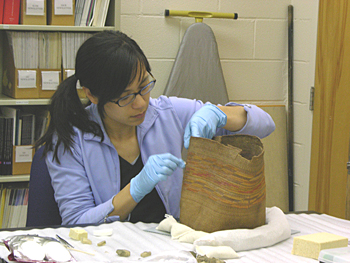Besides having a gorgeous backdrop of snow-capped mountains, evergreen forests and glaciers to explore, I am getting a well-rounded experience in the conservation of ethnographic materials. Luckily, I have a fellow intern, Molly Gleeson--a student in the UCLA/Getty program in the conservation of ethnographic and archaeological objects, to share this experience with and from whom to learn. Our internship began with problem-solving the consolidation of waterlogged archaeological basketry fragments that were carbon-dated to more than 4,000- and 5,000-years-old. This makes them the oldest basket fragments found in the U.S.
So far, I have been focusing on the treatment of two Tlingit baskets that were chosen because of the their historical significance as old baskets with decoration and evidence of use, as well as their current instability and continuing damage. The Tlingit and Haida traditionally used spruce root baskets for gathering and storage, folding them flat when they were not in use. The creases on these baskets indicate that they were made for use, rather than the tourist trade. My treatment of the baskets includes cleaning, reshaping, structural repairs and aesthetic compensation all done in consultation with Janice Criswell, a native basket weaver, Steve Henrikson, ASM curator of collections, and Ellen Carrlee, ASM conservator.
In addition to focusing on treatment, Molly and I are working with two native basket weavers to more fully understand the materials and techniques. Janice Criswell and Mary Lou King, her root-digging partner, took us out to gather spruce roots and taught us how to process them by roasting the roots in a fire, removing the bark, and splitting them to produce the necessary warps and wefts. Now we are learning the traditional methods of Haida and Tlingit weaving. After carrying out all of this work we can really understand why these baskets are so valuable. It is incredible to think that most of these baskets were woven during the few hours of daylight of winter when the women were not busy gathering and preparing food during the summer.
The final aspect of this internship is public outreach. We will be giving a presentation at the SJM on the conservation of baskets and hold an evening “clinic,” during which anyone can bring in their own treasures and get advice on how to care for them. In addition, we will be doing most of our work at the SJM in the gallery on view as a way of involving the public. I'm only halfway through the internship and I am amazed at how much I have already learned. I was lucky enough to have my husband join me out here, but unfortunately I don't think I'll be able to get him home.


